Overview
- Description
- Musical compositions, programs and documents illustrating the experiences of Emeric Lazar, Jewish, born in Hungary in 1903, surrounding the Holocaust in France, where he moved in the late 1920s to pursue his music and composition. Documents include baptismal certificate for Emeric dated 1942, affidavits of support, pre-war and post-war and pass and release papers from Drancy internment camp near Paris, from where he went into hiding until the liberation of France. Also included is a 1945 French document in lieu of birth certificate for Emeric upon the occasion of his marriage to Hedwiga Ferlin.
- Credit Line
- United States Holocaust Memorial Museum Collection, Gift of the children of Emeric Lazar
- Collection Creator
- Emeric M. Lazar
- Biography
-
Imre (Emeric) Lazar was born on July 8, 1903, in Vagbeszterce, Hungary, to a Jewish couple, Moritz (Maurice) and Malvine Rosenfeld Lazar. Moritz, a businessman, was born in 1878 in Vagbeszterce. Malvine was born in 1877 in Vienna, Austria. Soon after Imre’s birth, the family moved to Budapest. Imre’s brother Gyorgy, was born on June 18, 1906. The boys grew up with private teachers and governesses. When Imre was twelve, he began music lessons. He later studied music and composition in Budapest. In September 1928, Imre, now Emeric, was living in Pars. He had moved there to study at the Paris Conservatoire under Alfred Cortot, specializing in the piano. He performed solo and with his own orchestra, appearing in shows with Josephine Baker and touring with Jeannette MacDonald, and composed several popular songs. In 1933, Emeric became the house composer and a conductor for Le Casino de Paris. In 1939, his father Moritz died of heart disease in Budapest.
Germany invaded France on May 10, 1940. On June 22, France signed an armistice with Germany and Paris became the seat of the German military occupation in northern and western France. In August 1941, the Germans established Drancy internment camp in Paris to detain foreign born Jews. The camp was administered by French police until July 1943 when it was taken over by the German and an SS officer, Alois Brunner, was made commandant. Emeric was imprisoned in Drancy on August 21, 1941. By the summer of 1942, Drancy was a major transit camp for the deportation of Jews from France to concentration camps in Poland. Emeric acquired a copy of a French baptismal certificate, under the name Emeric Mattheiu Lazar, on July 10, 1942. He was released from Drancy on February 22, 1943. Emeric remained in Paris, living in hiding with the assistance of friends. The German forces in Paris surrendered on August 25, 1944.
After liberation, Emeric worked in an American Red Cross nightclub; the French clubs were closed. While working at the club, he met 1st Lieutenant Hedwiga Ferlin, a US Army nurse born in 1919 in Jolliet, Illinois. Hedwiga came to the club frequently to practice piano. They married in Paris on October 20, 1945. Emeric was given permission to immigrate to the US as the spouse of an American service member. The couple sailed from Bremerhaven, Germany, aboard the USAT Bridgeport on August 7, 1946, arriving in New York on August 24. They had a son and a daughter before moving to Florida in 1948, where they later had another son and daughter. Emeric continued composing, and established himself as a music teacher in St. Petersburg. He became a naturalized citizen in 1950. Emeric’s brother Gyorgy, and his wife, the former Ilona Esslinger, both furriers, had survived the war by living in hiding in Budapest. In 1949, Gyorgy was co-director of the Hungarian Foreign Trade Committee. In September, when the other director, Erdi, was arrested by the government, Gyorgy decided to flee Hungary, as he had been vocal opponent of many Communist policies. With the assistance of the Bricha organization, they reached Hallein displaced persons camp in Austria. In 1951, they emigrated to Brazil. Emeric’s mother, age 85, died in 1962 in Budapest. Emeric, age 81, died in St. Petersburg on January 8, 1984. Emeric's brother Gyorgy died in November 1983.
Physical Details
- Extent
-
1 folder
2 oversize folders
Rights & Restrictions
- Conditions on Access
- There are no known restrictions on access to this material.
- Conditions on Use
- Material(s) in this collection may be protected by copyright and/or related rights. You do not require further permission from the Museum to use this material. The user is solely responsible for making a determination as to if and how the material may be used.
- Copyright Holder
- Emeric M. Lazar
Administrative Notes
- Holder of Originals
-
United States Holocaust Memorial Museum
- Legal Status
- Permanent Collection
- Provenance
- The papers were donated to the United States Holocaust Memorial Museum in 2012 by Stephen F. Lazar, Alessandra Bergstrom, George Lazar, and Linda Walker, the children of Emeric Lazar.
- Record last modified:
- 2022-07-28 17:51:07
- This page:
- https://collections.ushmm.org/search/catalog/irn48062
Download & Licensing
- In Copyright - Use Permitted
- Terms of Use
- This record is digitized but cannot be downloaded online.
In-Person Research
- Requires Research Visit
- Plan a Research Visit
-
Request in Shapell Center Reading Room
Bowie, MD
Contact Us
Also in Emeric Lazar collection
The collection consists of drawings and documents related to the experiences of Emeric Lazar in prewar Budapest, Hungary, and before, during, and after the Holocaust in Paris, France, during which he was imprisoned in Drancy internment camp.
Date: approximately 1941-1946
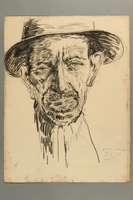
Portrait of an old man wearing a hat created by a Hungarian Jewish musician in Drancy internment camp
Object
Pencil drawing of an old man with a weathered face created by Emeric Lazar in February 1943 while imprisoned in Drancy internment camp in Paris, France. Emeric had come to Paris from Budapest in 1928 to study music. He was the house composer at Le Casino de Paris when Nazi Germany invaded France in May 1940. France surrendered in June and Paris became the seat of the German military occupation. Anti-Jewish measures were enacted and, in August, an internment camp for foreign Jews was established in Drancy, a northeastern suburb of Paris. Emeric was imprisoned there on August 21, 1941. The camp became a major transit center for the deportation of Jews. In the summer of 1942, the Germans systematically deported Jews from Drancy to killing centers in Poland. On July 10, 1942, Emeric obtained a copy of his French baptism certificate from the archives of the Archbishop of Paris. He was released from Drancy on February 22, 1943. The camp was staffed by French police until July 1, 1943, when the Germans took control of the camp. Emeric lived in hiding in Paris until the city was liberated by American troops on August 25, 1944. Emeric then worked in an American Red Cross nightclub where he met US Army Lieutenant Hedwiga Ferlin. She came to the club during the day to practice the piano. The couple married on October 20, 1945, and left for New York in August 1946.
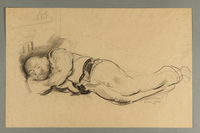
Drawing of a sleeping man created by a Hungarian Jewish musician in Drancy internment camp
Object
Pencil drawing of a man sleeping on his side created by Emeric Lazar in 1941 while imprisoned in Drancy internment camp in Paris, France. Emeric had come to Paris from Budapest in 1928 to study music. He was the house composer at Le Casino de Paris when Nazi Germany invaded France in May 1940. France surrendered in June and Paris became the seat of the German military occupation. Anti-Jewish measures were enacted and, in August, an internment camp for foreign Jews was established in Drancy, a northeastern suburb of Paris. Emeric was imprisoned there on August 21, 1941. The camp became a major transit center for the deportation of Jews. In the summer of 1942, the Germans systematically deported Jews from Drancy to killing centers in Poland. On July 10, 1942, Emeric obtained a copy of his French baptism certificate from the archives of the Archbishop of Paris. He was released from Drancy on February 22, 1943. The camp was staffed by French police until July 1, 1943, when the Germans took control of the camp. Emeric lived in hiding in Paris until the city was liberated by American troops on August 25, 1944. Emeric then worked in an American Red Cross nightclub where he met US Army Lieutenant Hedwiga Ferlin. She came to the club during the day to practice the piano. The couple married on October 20, 1945, and left for New York in August 1946.
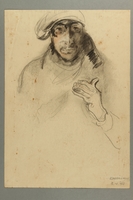
Portrait of a young man in a cap created by a Hungarian Jewish musician in Drancy internment camp
Object
Portrait drawing of a young man in a cap created by Emeric Lazar in January 1943 while imprisoned in Drancy internment camp in Paris, France. Emeric had come to Paris from Budapest in 1928 to study music. He was the house composer at Le Casino de Paris when Nazi Germany invaded France in May 1940. France surrendered in June and Paris became the seat of the German military occupation. Anti-Jewish measures were enacted and, in August, an internment camp for foreign Jews was established in Drancy, a northeastern suburb of Paris. Emeric was imprisoned there on August 21, 1941. The camp became a major transit center for the deportation of Jews. In the summer of 1942, the Germans systematically deported Jews from Drancy to killing centers in Poland. On July 10, 1942, Emeric obtained a copy of his French baptism certificate from the archives of the Archbishop of Paris. He was released from Drancy on February 22, 1943. The camp was staffed by French police until July 1, 1943, when the Germans took control of the camp. Emeric lived in hiding in Paris until the city was liberated by American troops on August 25, 1944. Emeric then worked in an American Red Cross nightclub where he met US Army Lieutenant Hedwiga Ferlin. She came to the club during the day to practice the piano. The couple married on October 20, 1945, and left for New York in August 1946.

Portrait of two bearded men created by a Hungarian Jewish musician in Drancy internment camp
Object
Portrait drawing of two bearded men created by Emeric Lazar in January 1943 while imprisoned in Drancy internment camp in Paris, France. Emeric had come to Paris from Budapest in 1928 to study music. He was the house composer at Le Casino de Paris when Nazi Germany invaded France in May 1940. France surrendered in June and Paris became the seat of the German military occupation. Anti-Jewish measures were enacted and, in August, an internment camp for foreign Jews was established in Drancy, a northeastern suburb of Paris. Emeric was imprisoned there on August 21, 1941. The camp became a major transit center for the deportation of Jews. In the summer of 1942, the Germans systematically deported Jews from Drancy to killing centers in Poland. On July 10, 1942, Emeric obtained a copy of his French baptism certificate from the archives of the Archbishop of Paris. He was released from Drancy on February 22, 1943. The camp was staffed by French police until July 1, 1943, when the Germans took control of the camp. Emeric lived in hiding in Paris until the city was liberated by American troops on August 25, 1944. Emeric then worked in an American Red Cross nightclub where he met US Army Lieutenant Hedwiga Ferlin. She came to the club during the day to practice the piano. The couple married on October 20, 1945, and left for New York in August 1946.
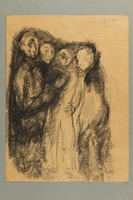
Expressionistic drawing of four men standing together created by a Hungarian Jewish musician in Drancy
Object
Group portrait drawing created by Emeric Lazar in January 1943 while imprisoned in Drancy internment camp in Paris, France. Emeric had come to Paris from Budapest in 1928 to study music. He was the house composer at Le Casino de Paris when Nazi Germany invaded France in May 1940. France surrendered in June and Paris became the seat of the German military occupation. Anti-Jewish measures were enacted and, in August, an internment camp for foreign Jews was established in Drancy, a northeastern suburb of Paris. Emeric was imprisoned there on August 21, 1941. The camp became a major transit center for the deportation of Jews. In the summer of 1942, the Germans systematically deported Jews from Drancy to killing centers in Poland. On July 10, 1942, Emeric obtained a copy of his French baptism certificate from the archives of the Archbishop of Paris. He was released from Drancy on February 22, 1943. The camp was staffed by French police until July 1, 1943, when the Germans took control of the camp. Emeric lived in hiding in Paris until the city was liberated by American troops on August 25, 1944. Emeric then worked in an American Red Cross nightclub where he met US Army Lieutenant Hedwiga Ferlin. She came to the club during the day to practice the piano. The couple married on October 20, 1945, and left for New York in August 1946.
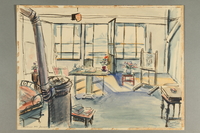
Watercolor sketch of his postwar Parisian studio created by a Hungarian Jewish musician
Object
Watercolor sketch of his studio in Paris created by Emeric Lazar in 1945. Emeric had come to Paris from Budapest in 1928 to study music. He was the house composer at Le Casino de Paris when Nazi Germany invaded France in May 1940. France surrendered in June and Paris became the seat of the German military occupation. Anti-Jewish measures were enacted and, in August, an internment camp for foreign Jews was established in Drancy, a northeastern suburb of Paris. Emeric was imprisoned there by August 21, 1941. The camp became a major transit center for the deportation of Jews. In the summer of 1942, the Germans systematically deported Jews from Drancy to killing centers in Poland. On July 10, 1942, Emeric obtained a copy of his French baptism certificate from the archives of the Archbishop of Paris. He was released from Drancy on February 22, 1943. The camp was staffed by French police until July 1, 1943, when the Germans took control of the camp. Emeric lived in hiding in Paris until the city was liberated by American troops on August 25, 1944. Emeric then worked in an American Red Cross nightclub where he met US Army Lieutenant Hedwiga Ferlin. She came to the club during the day to practice the piano. The couple married on October 20, 1945, and left for New York in August 1946.

Self portrait in red conte crayon by a Hungarian Jewish musician while living in hiding
Object
Self portrait by Emeric Lazar in 1944 while he was living in hiding Paris, France, after his February 1943 release from Drancy internment camp. Emeric had come to Paris from Budapest in 1928 to study music. He was the house composer at Le Casino de Paris when Nazi Germany invaded France in May 1940. France surrendered in June and Paris became the seat of the German military occupation. Anti-Jewish measures were enacted and, in August, an internment camp for foreign Jews was established in Drancy, a northeastern suburb of Paris. Emeric was imprisoned there on August 21, 1941. The camp became a major transit center for the deportation of Jews. In the summer of 1942, the Germans systematically deported Jews from Drancy to killing centers in Poland. On July 10, 1942, Emeric obtained a copy of his French baptism certificate from the archives of the Archbishop of Paris. He was released from Drancy on February 22, 1943. The camp was staffed by French police until July 1, 1943, when the Germans took control of the camp. Emeric lived in hiding in Paris until the city was liberated by American troops on August 25, 1944. Emeric then worked in an American Red Cross nightclub where he met US Army Lieutenant Hedwiga Ferlin. She came to the club during the day to practice the piano. The couple married on October 20, 1945, and left for New York in August 1946.



